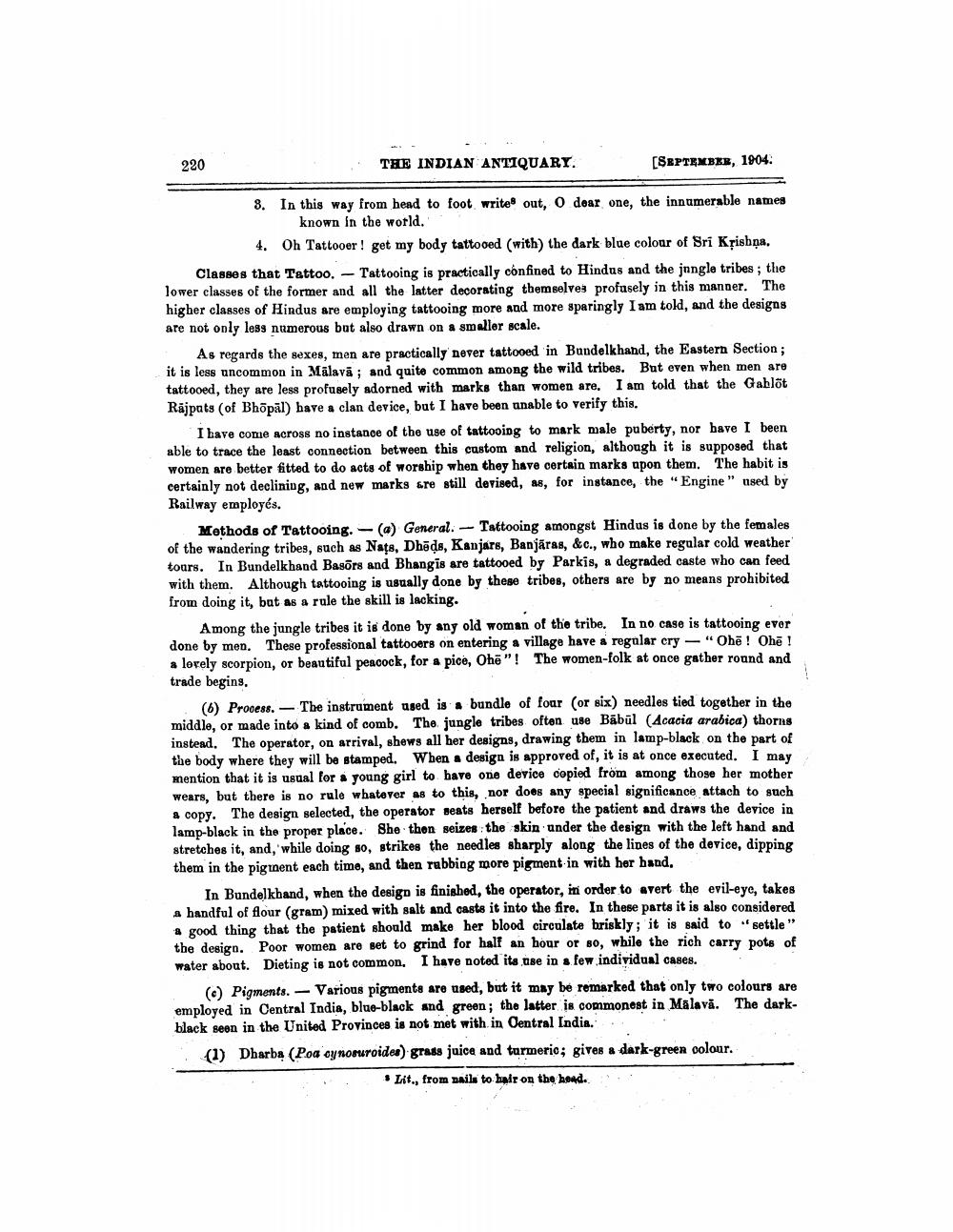________________
220
THE INDIAN ANTIQUARY.
[SEPTEMBRE, 1904.
8. In this way from head to foot writes out, Odear one, the innumerable names
known in the world.
4. Oh Tattooer! get my body tattooed (with) the dark blue colour of Sri Kțisboa. Classes that Tattoo - Tattooing is practically confined to Hindus and the jungle tribes; the lower classes of the former and all the latter decorating themselves profusely in this manner. The higher classes of Hindus are employing tattooing more and more sparingly I am told, and the designs are not only less numerous but also drawn on a smaller scale.
As regards the sexes, men are practically never tattooed in Bundelkhand, the Eastern Section ; it is less uncommon in Mälava ; and quite common among the wild tribes. But even when men are tattooed, they are less profusely adorned with marks than women are. I am told that the Gablot Rājputs (of Bhopal) have a clan device, but I have been unable to verify this.
I have come across no instance of the use of tattooing to mark male puberty, nor have I been able to trace the least connection between this custom and religion, although it is supposed that women are better fitted to do acts of worship when they have certain marks upon them. The habit is certainly not declining, and new marks are still devised, as, for instance, the "Engine” used by Railway employés.
Methods of Tattooing. - (a) General. - Tattooing amongst Hindus is done by the females of the wandering tribes, such as Nats, Dhēds, Kanjars, Banjäras, &c., who make regular cold weather toars. In Bundelkhand Basors and Bhangis are tattooed by Parkis, a degraded caste who can feed with them. Although tattooing is usually done by these tribes, others are by no means prohibited from doing it, but as a rule the skill is lacking.
Among the jungle tribes it is done by any old woman of the tribe. In no case is tattooing ever done by men. These professional tattooers on entering a village have a regular cry - "Ohē! Ohē! a lovely scorpion, or beautiful peacock, for a pice, Ohē"! The women-folk at once gather round and trade begins.
(6) Process. The instrument used is a bundle of four (or six) needles tied together in the middle, or made into a kind of comb. The jungle tribes often use Bābül (Acacia arabica) thorns instead. The operator, on arrival, shews all her designs, drawing them in lamp-black on the part of the body where they will be stamped. When a design is approved of, it is at once executed. I may mention that it is usual for a young girl to have one device copied from among those her mother wears, but there is no rule whatever as to this, nor does any special significance attach to such a copy. The design selected, the operator seats herself before the patient and draws the device in lamp-black in the proper place. She thon seizes the skin under the design with the left hand and stretches it, and, while doing so, strikes the needles sharply along the lines of the device, dipping them in the pigment each time, and then rabbing more pigment in with her hand,
In Bundelkhand, when the design is finished, the operator, in order to avert the evil-eye, takes handful of flour (gram) mixed with salt and casts it into the fire. In these parts it is also considered a good thing that the patient should make her blood circulate briskly; it is said to settle" the design. Poor women are set to grind for half an hour or so, while the rich carry pots of water about. Dieting is not common. I have noted its use in a few individual cases.
(6) Pigments. - Various pigments are used, but it may be remarked that only two colours are employed in Central India, blue-black and green; the latter is commonest in Malavă. The darkblack seen in the United Provinces is not met with in Central India. (1) Dharba (Poa cynosuroides) grass juice and turmeric; gives a dark-green colour.
Lit., from Dails to hair on the head.




